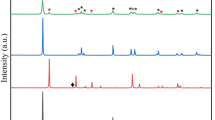Abstract
This study describes the application of Ag/Nb2O5 catalysts, suspension and spheres alginate immobilized for the degradation of 17α-Ethinylestradiol (EE2). The techniques used to characterize the photocatalysts were as follows: X-ray diffraction (XRD), N2 adsorption–desorption analysis (BET), point charge zero charge (PZC), scanning electron microscopy (SEM) and energy dispersive X-ray spectroscopy (EDS). Different catalyst calcination temperatures were studied by keeping the silver metal loading at 5%. Among the operational conditions analyzed were pH, catalyst concentration, the emitting source of radiation and the inlet flow rate (in continuous operation). The results of the experiments performed initially with the catalyst in suspension revealed that the highest catalytic activity in the degradation of EE2 was the 5%Ag/Nb2O5 catalyst calcined at 973 K, which removed 77.7% of the initial pollutant concentration in 120 min of reaction. The immobilization of the catalyst in alginate spheres resulted in a degradation reduction, being able to degrade 69.2% of the initial EE2 in a batch system. In the continuous system, the immobilized catalyst obtained a total degraded of 37.3%, with a flow rate of 10 L·h−1. Catalyst reuse was promising, even dropping the removal, degrading around 27% of the initial EE2 concentration in the third cycle of use.










Similar content being viewed by others
References
Cates EL (2017) Photocatalytic water treatment: so where are we going with this? Environ Sci Technol 51:757–758. https://doi.org/10.1021/acs.est.6b06035
Focazio MJ, Kolpin DW, Barnes KK et al (2008) A national reconnaissance for pharmaceuticals and other organic wastewater contaminants in the United States - II) Untreated drinking water sources. Sci Total Environ 402:201–216. https://doi.org/10.1016/j.scitotenv.2008.02.021
Ribeiro CCM, Shimo AKK, de Lopes MHB, Lamas JLT (2018) Effects of different hormonal contraceptives in women’s blood pressure values. Rev Bras Enferm 71:1453–1459. https://doi.org/10.1590/0034-7167-2017-0317
da Cunha DL, da Silva SMC, Bila DM et al (2016) Regulation of the synthetic estrogen 17α-ethinylestradiol in water bodies in Europe, the United States, and Brazil. Cad Saude Publica 32:e00056715. https://doi.org/10.1590/0102-311X00056715
Froehner S, Souza DB, MacHado KS, Da Rosa EC (2010) Tracking anthropogenic inputs in Barigui River, Brazil using biomarkers. Water Air Soil Pollut 210:33–41. https://doi.org/10.1007/s11270-009-0220-8
Fidelis MZ, Abreu E, Josué TG et al (2020) Continuous process applied to degradation of triclosan and 2.8-dichlorodibenzene-p-dioxin. Environ Sci Pollut Res. https://doi.org/10.1007/s11356-020-10902-0
Serna-Galvis EA, Botero-Coy AM, Martínez-Pachón D et al (2019) Degradation of seventeen contaminants of emerging concern in municipal wastewater effluents by sonochemical advanced oxidation processes. Water Res 154:349–360. https://doi.org/10.1016/j.watres.2019.01.045
Yan J, Wu G, Guan N, Li L (2014) Nb2O5/TiO2 heterojunctions: Synthesis strategy and photocatalytic activity. Appl Catal B Environ 152–153:280–288. https://doi.org/10.1016/j.apcatb.2014.01.049
Josué TG, Almeida LNB, Lopes MF et al (2020) Cr (VI) reduction by photocatalyic process: Nb2O5 an alternative catalyst. J Environ Manage 268:110711. https://doi.org/10.1016/j.jenvman.2020.110711
Moon YJ, Myung SW (2016) Determination of estrogens in environmental aqueous samples using dispersive liquid-liquid microextraction and HPLC/UV–vis system. Bull Korean Chem Soc 37:2009–2014. https://doi.org/10.1002/bkcs.11016
Almeida LNB, Lenzi GG, Pietrobelli JMTA, Santos OAA (2019) Caffeine degradation using ZnO and Ag/ZnO under UV and solar radiation. Desalin Water Treat 153:85–94. https://doi.org/10.5004/dwt.2019.24045
Chaker H, Chérif-Aouali L, Khaoulani S et al (2016) Photocatalytic degradation of methyl orange and real wastewater by silver doped mesoporous TiO2 catalysts. J Photochem Photobiol A Chem 318:142–149. https://doi.org/10.1016/j.jphotochem.2015.11.025
Lenzi GG, Fávero CVB, Colpini LMS et al (2011) Photocatalytic reduction of Hg(II) on TiO2 and Ag/TiO2 prepared by the sol–gel and impregnation methods. Desalination 270:241–247. https://doi.org/10.1016/j.desal.2010.11.051
Paulis M, Martı́n M, Soria D et al (1999) Preparation and characterization of niobium oxide for the catalytic aldol condensation of acetone. Appl Catal A Gen 180:411–420. https://doi.org/10.1016/S0926-860X(98)00379-2
Gonçalves G, Lenzi MK, Santos OAA, Jorge LMM (2006) Preparation and characterization of nickel based catalysts on silica, alumina and titania obtained by sol–gel method. J Non Cryst Solids 352:3697–3704. https://doi.org/10.1016/j.jnoncrysol.2006.02.120
Domingues FS, Geraldino HCL, de Freitas TKF et al (2019) Photocatalytic degradation of real textile wastewater using carbon black-Nb2O5 composite catalyst under UV/Vis irradiation. Environ Technol. https://doi.org/10.1080/09593330.2019.1701565
Kosmulski M (2009) Surface Charging and Points of Zero Charge. CRC Press, Boca Raton
Bolzon LB, Prado AGS (2011) Effect of protonation and deprotonation on surface charge density of Nb2O5. J Therm Anal Calorim 106:427–430. https://doi.org/10.1007/s10973-011-1316-0
Fidelis MZ, Abreu E, Dos Santos O et al (2019) Experimental design and optimization of triclosan and 2.8-diclorodibenzeno-p-dioxina degradation by the Fe/Nb2O5/UV system. Catalysts 9:343. https://doi.org/10.3390/catal9040343
Liu X, Qin C, Huang Y et al (2017) A new silver niobate photocatalyst AgNb13O33: synthesis, structure and photochemical properties. J Taiwan Inst Chem Eng 78:530–538. https://doi.org/10.1016/j.jtice.2017.06.034
Chen Z, Cheng X, Ye W et al (2019) AgNb13O33: a new anode material with high energy storage performance. Chem Eng J 366:246–253. https://doi.org/10.1016/j.cej.2019.02.091
Liu XX, Qin C, Cao L et al (2017) A silver niobate photocatalyst AgNb7O18 with perovskite-like structure. J Alloys Compd 724:381–388. https://doi.org/10.1016/j.jallcom.2017.07.048
Woodward DI, Beanland R (2014) ChemInform abstract: AgNb 7 O 18: an ergodic relaxor ferroelectric. ChemInform https://doi.org/10.1002/chin.201442005
Zhang C, Li Y, Wang D et al (2015) Ag@helical chiral TiO2 nanofibers for visible light photocatalytic degradation of 17α-ethinylestradiol. Environ Sci Pollut Res 22:10444–10451. https://doi.org/10.1007/s11356-015-4251-y
Li S, Sun W (2014) Photocatalytic degradation of 17α-ethinylestradiol in mono- and binary systems of fulvic acid and Fe(III): Application of fluorescence excitation/emission matrixes. Chem Eng J 237:101–108. https://doi.org/10.1016/j.cej.2013.10.002
Acknowledgements
The authors are thankful to the Brazilian agencies CNPq, CAPES and Fundação Araucária for financial support of this work, C2MMa and Brazilian Mining and Metallurgy Company – CBMM and are grateful to the Foundation for Science and Technology (FCT, Portugal) and FEDER (Fundo Eropeu de Desenvolvimento Regional) under Programme PT2020 for financial support to CIMO (UIDB/00690/2020).
Author information
Authors and Affiliations
Corresponding author
Additional information
Publisher's Note
Springer Nature remains neutral with regard to jurisdictional claims in published maps and institutional affiliations.
Rights and permissions
About this article
Cite this article
Lenzi, G.G., Abreu, E., Fuziki, M.E.K. et al. 17 α-Ethinylestradiol Degradation in Continuous Process by Photocatalysis Using Ag/Nb2O5 Immobilized in Biopolymer as Catalyst. Top Catal 65, 1225–1234 (2022). https://doi.org/10.1007/s11244-022-01624-3
Accepted:
Published:
Issue Date:
DOI: https://doi.org/10.1007/s11244-022-01624-3




